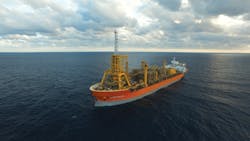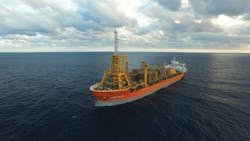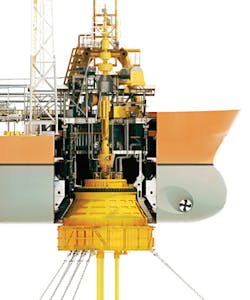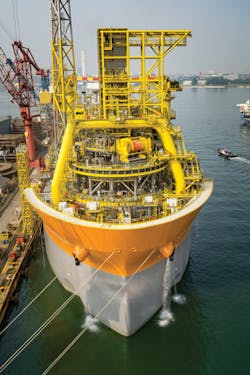The Turritella floating, production, storage and offloading vessel became the second FPSO moored in the US Gulf of Mexico (GOM) when Stones came on stream September 2016. Shell committed to developing Stones in May 2013, only 3 years after the 2010 Macondo well blowout, which resulted in a massive oil spill and subsequent US offshore regulatory uncertainties. BP PLC operated Macondo.
Turritella represents Shell's first FPSO in the gulf and its 13th FPSO worldwide. Petrobras brought the first FPSO on stream in the GOM for its Cascade-Chinook development.
Stones is in 9,500 ft of water about 200 miles southeast of New Orleans. Stones marks Shell's second producing field in the high-pressure, high-temperature (HPHT) Lower Tertiary trend where Perdido field came on stream in 2010 with a production platform.
SBM Offshore operates Turritella under a 10-year charter with Shell Offshore Inc. SBM Offshore holds 55% interest ownership of the vessel. Joint-venture partners are Mitsubishi Corp. (30%) and Nippon Yusen Kabushike Haisha (15%). They converted a Suezmax tanker into the Turritella.
Shell was part of a consortium that discovered Stones in 2005 on Walker Ridge Block 508. Shell now owns and operates 100% of Stones field, which covers eight federal blocks or 72 sq miles on the US Outer Continental Shelf. It's a complex subsurface area with the reservoir depth about 26,500 ft below sea level and 17,000 ft below the sea floor. Stones produces primarily oil with some associated natural gas.
The first-phase Stones development is expected to produce about 50,000 boe/d by Dec. 31 when full production is reached. Turritella can store 800,000 bbl of crude and process 60,000 b/d of oil and 15 MMcfd of gas. Tankers move oil to refineries in Texas and Louisiana while a pipeline moves gas to a gathering system.
FPSO downturn
Peter Lovie, a consultant and principal of Peter M. Lovie PE LLC in Houston, told OGJ that he is unaware of any more FPSOs "on the drawing boards" for the US GOM. "I am skeptical of any more in the next 10 years," he said.
Lovie said the FPSO industry is experiencing its worst downturn ever.
Industry has drastically cut capital expenditures since the ongoing oil price slump started in late 2014.
"No one knows how long this will go," Lovie said.
"Low-cost oil can still mean business for FPSOs in some places worldwide," Lovie said, while also noting that some owners of idle FPSOs face mounting pressure to accept writedowns and possibly scrap the vessels. Consequently, Lovie calls Stones "a glistening positive in today's sea of cutbacks and layoffs."
Major projects can produce for 50 years so near-term market fluctuations are not a consideration, according to Ian Silk, Shell E&P Co.'s vice president for deep water. Silk said Shell estimates average oil prices over several decades when deciding whether to sanction a project. The company selected an FPSO to avoid the expense of laying long oil pipelines at extreme water depths.
Stones startup phase involved two subsea wells, Stones-5R and Stones-9, which came on stream in September 2016. The second phase calls for six more wells. Shell plans to use multiphase seafloor pumps to lift oil and gas from the seabed to the FPSO.
A 15,000-psi subsea pump system will tie back to Turritella. Infrastructure will include a subsea dual pump station with two 3-Mw single-phase pumps and two control modules and a topsides power and control module, all to be provided by OneSubsea.
OneSubsea reports that manufacturing and testing is under way in Horsoy, Norway, with delivery of the subsea pump system expected in 2018. OneSubsea is a Schlumberger Ltd. and Cameron subsidiary.
Turret, buoyant mooring
The Turritella features a turret assembly with a buoyant mooring that allowing the FPSO to rotate freely around the buoy as the wind and currents change. The mooring system is permanently fixed to the seabed while the FPSO can disconnect from the buoy if a hurricane approaches.
The buoy is 82 ft. tall, 82 ft. in diameter, and weighs 3,150 tonnes. It's the world's largest disconnectable buoy and the first to use a lazy-wave riser configuration in which an S-curve in the steel catenary riser adds buoyancy.
The buoy supports power and control umbilical lines, the steel riser system, and a gas-export riser. Suction piles and nine mooring lines secure the buoy to the seabed. The mooring lines are chain and polyester rope. Workers adjust line tension as needed with inline-mooring connectors.
Engineeers designed the buoy and riser system as a safety feature to eliminate the possibility of the FPSO or other vessels colliding with the project infrastructure in case of rough seas.
Uncoupling the buoy takes about 2 hr, depending on wind and currents. The disconnected buoy descends on its own to equilibrium depth in about 30 sec. Crews can reconnect the Turritella to the buoy in about 8 hr, depending on wind and currents.
"FPSO disconnection in US GOM was an operator initiative, not regulatory or a Washington decree," Lovie said.
The US government approved FPSOs in the GOM in December 2001. The 2005 hurricane season demonstrated the need for FPSOs to be able to disconnect and move away in case of tropical weather.
Hurricanes Katrina and Rita set 12 mobile offshore drilling units adrift with complete mooring failures. Many more MODUs experienced partial mooring failures. Unmoored MODUs damaged numerous platforms and pipelines (See table).
The BW Pioneer FPSO arrived in the US GOM in April 2010 for use on Petrobas' ultradeep Cascade-Chinook project only 2 weeks before the Macondo incident. Petrobras began Chinook production Sept. 6, 2012.
Turritella arrived in the GOM Jan. 1, 2016.
Subsea production
Technip and FMC Technologies installed the subsea production trees and gas pipeline. The companies have merged to become TechnipFMC PLC.
Shell's Stones project is indicative of industry's desire-capital budget realities nothwithstanding-to move away from moored platforms and extensive pipeline infrastructure in favor of FPSOs, especially for deepwater and ultradeepwater projects.
Future projects will be designed to handle complex, deep HPHT reservoirs. SBM Offshore notes Lower Tertiary reservoirs are in extreme depths with high pressure and typically found under salt or tar. These conditions can result in uneven porosity and permeability.
Curtis Lohr, Shell's project manager in charge of Stones development, said numerous project issues specific to Stones had to be resolved. He called Stones "a frontier play," saying much has yet to be learned about its reservoir.
He said the ultradeepwater setting causes high tension on the FPSO buoy. The gas pipeline traverses an escarpment that features a 2,000-ft rise. Furrows on the seabed also complicated pipeline logistics.
The pipeline used vortex-induced vibration suppression to prevent fatigue issues. Pipeline walls were made thick enough to span the furrows.





